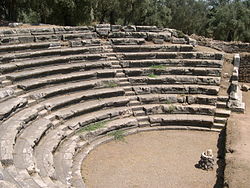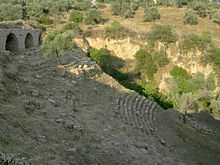- Nysa (Caria)
-
Nysa (Ancient Greek: Νῦσα) was an ancient city of Caria in Anatolia, whose remnants are now in the Sultanhisar district of Aydın Province of Turkey, 50 kilometers (31 mi) east of the Ionian city of Ephesus.
The name "Nysa" was mentioned in Homer's Iliad (Chapter 6.132-133), where he refers to a hero named Lycurgus, "who once drove the nursing mothers of wine-crazed Dionysus over the sacred mountains of Nysa." Most likely in connection to this, the city was dedicated to Dionysus when it was founded, perhaps by Antiochus I Soter in the 3rd century BC. Nysa not only gained fame through Dionysus, but also through its scholars. The big library of Nysa stands proof of this period.
In antiquity, Nysa was also known as Athymbra (Ancient Greek Ἄθυμβρα); according to Strabo, who started his life of study in Nysa (which was an important center of learning in the 1st century BC), "Nysa resulted from a synoecism of three towns that were founded by three brothers, Athymbros, Athymbrados, and Hydrelos. Undoubtedly Athymbra served as the kernel for the later Nysa. The townspeople were still called Athymbrianoi in a letter sent ... in 281 BC."[1] For about a thousand years after that the city suffered from the depredations of the Christians, the Muslims and the Turks, and it was finally abandoned after being sacked by Tamerlane in 1402.
There are important ruins on the site from the Hellenistic period, the Roman period and the Byzantine era. The well-preserved theater, built during the Roman Imperial period, is famous for its frises depicting the life of Dionysus, god of the grape harvest, winemaking and wine. It has a capacity 12.000 people. The library dating from the 2nd century A.D. is considered to be Turkey's second-best preserved ancient library structure after the "Celsus Library" of Ephesus. The stadium of Nysa, which suffered from floods and is therefore partially damaged, has a capacity of 30.000 people. The bouleuterion with 12 rows of seats, offers room for up to 600-700 people. Other significant structures include the agora, gymnasion and the Roman bath. The 100 m long Nysa Bridge, a tunnel-like substructure, was the second largest of its kind in antiquity.[2]
Notes
- ^ Getzel M. Cohen, The Hellenistic Settlements in Europe, the Islands, and Asia Minor (University of California Press, 1996: ISBN 0520083296), p. 257.
- ^ Klaus Grewe, Ünal Özis et al.: "Die antiken Flußüberbauungen von Pergamon und Nysa (Türkei)", Antike Welt, Vol. 25, No. 4 (1994), pp. 348–352 (352)
Categories:- Seleucid colonies in Anatolia
- Hellenistic Caria
- Ancient Greek cities
- Former populated places in Turkey
- Aydın Province
- History of Aydın Province
- Ancient Greece stubs
- Aegean Region geography stubs
Wikimedia Foundation. 2010.


